CDMA-Near-Far Problem
CDMA - Near-Far Problem
Introduction:
Code Division Multiple Access, CDMA, refers to mobile communication digital cellular technology. CDMA is the foundation for access techniques, such as cdmaOne, CDMA2000, and WCDMA. CDMA cellular systems are considered superior to FDMA & TDMA, so CDMA is essential in developing efficient, robust, and safe radio communication systems.
Because Code Division Multiple Access, or CDMA, wireless communication technology employs separate codes to distinguish each user's signals, multiple users can share the same frequency band. CDMA, like other transmission methods, might suffer from the near-far issue. Before understanding Near far problem, lets have basic understanding of CDMA.
CDMA's Highlights
CDMA, which is based upon the spread spectrum technology, has the following highlights:
- Every channel in CDMA makes use of the entire available spectrum.
- Every conversation is encoded with a pseudo-random digital sequence and then broadcast over a broad frequency range.
- CDMA continually offers increased capacity for both data and voice connections, letting more users link at any point in time.
- The common platform on which 3G network technologies are constructed is CDMA. CDMA employs 1x EV-DO & EV-DV for 3G.
Standards for the Third Generation:
The frequency Divide Duplexing-Multicarrier (FDD-MC) mode is used by CDMA2000. In this context, multicarrier means N 1.25 MHz channels superimposed on N existent IS-95 carriers or placed on empty airwaves. CDMA2000 incorporates
- 1x — a spreading rate equal to 1.2288 Mcps is used.
- 3x — utilizes a spreading rate of 3.6864 Mcps or 3 1.2288 Mcps.
- 1xEV-DO (1x Evolution - Data Optimised) — employs a data-optimized spreading rate of 1.2288 Mcps.
- WCDMA/FDD-DS — Frequency Divide Duplexing-Direct Sequencing Spreading (FDD-DS) mode of Wideband CDMA (WCDMA). This only has one 5 MHz channel. WCDMA utilizes a single carrier per channel with a spreading rate of 3.84 Mcps.
CDMA Development Groups (CDG):
The CDMA Development Group (CDG), established in December 1993, is a worldwide business collaboration. It collaborates to drive the development and evolution of innovative wireless telecommunication technologies.
Service providers, infrastructural manufacturers, devices suppliers, test equipment vendors, developers of applications, and content providers make up CDG. Its members collaborate to determine the technical criteria for development of CDMA2000 and 4G complementing systems. Furthermore, interoperability with other upcoming wireless technologies is intended to expand the availability of Bluetooth products and services for consumers and businesses around the world.
CDMA - Channels
CDMA channels are divided into two types: forward channels and reverse channels. This article describes the functions of various channels.
1.Forward Channel:
The Forward channel is the communication / mobile-to-cell downlink path's direction. It contains the following channels: −
- The Pilot Channel- The pilot channel serves as a reference channel. It acquires time from the mobile station and uses it as a stage reference during coherent demodulation. Each base station continuously transmits it on every active CDMA frequency. And each mobile station continuously monitors this signal.
- Sync Channel- A synchronization channel transmits a single, repeated message to the mobile device that contains data about the time & system settings. Similarly, by synchronizing to the short code, a mobile device can obtain the actual system time.
- Paging Channel- The primary goal of the Paging Channel was to send out each page, which is a notification for incoming calls to mobile stations. These pages are used by the base station to send system overhead data and mobile station-specific messages.
- Forward Traffic Channel- Code Channel Forward Traffic Channel are code channels. It is used to route calls, often voice and signaling traffic, to certain users.
2. Reverse Channel:
The Reverse channel forms the mobile-to-cell communication path, also known as the uplink path. It is made up of the following channels:
- Access Channel- Mobile stations use the Access Channel to establish connection with the base stations or to respond to Paging Channel messages. The access channels are utilized for brief signaling message exchanges, including call-ups, page replies, and registrations.
- Reverse Traffic Channel- Individual users use reverse traffic channels in their actual conversations to transport traffic from an individual mobile station to more than one base station.
Multiple Access Methods (CDMA)
The ability to function in FDD / TDD mode allows for more effective utilization of available spectrum based on frequency allotment in different regions.
A duplex approach in which the Uplink and Downlink broadcasts employ two distinct frequency bands.
Uplink- 1920 MHz - 1980 MHz
Downlink- frequencies range from 2110 to 2170 MHz.
Bandwidth- Each carrier is in the middle of a 5 MHz broadband.
Separation of the Channels:
The nominal value for 5 MHz is adjustable.
channel raster- 200 kHz (the canter frequency should be multiples of 200 kHz).
Separation of Tx and Rx Frequencies:
The nominal frequency is 190 MHz. This value can belong to a constant or variable (with a minimum of 134.8 MHz and a maximum of 245.2 MHz).
Channel Identification:
The UTRA Absolutely Radio Frequencies Channels Number (UARFCN) identifies the carrier frequency. The value of this number is transmitted by the network on the BCCH logical channel (for the uplink and downlink) and is defined as Nu Equal 5 * (Frequency uplink MHz) & ND Equal 5 * (Frequency downlink MHz).
Duplex Time Division:
Time-divided duplex is a technology that uses synchronized time intervals to carry uplink and downlink broadcasts on the same frequency. The carrier operates on a 5 MHz band, though the 3GPP is investigating a low chip rate option (1.28 Mcps). TDD will be accessible in two frequency bands: 1900-1920 MHz and 2010-2025 MHz.
Duplex Radio Link Methods:
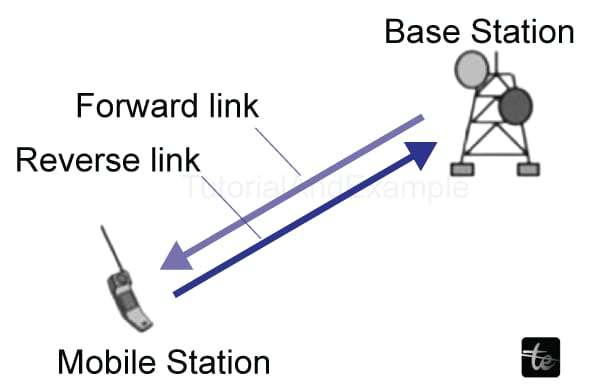
In the scenario for Time Division Duplex, both the forward and reverse link frequencies are the same. Signals are continuously transmitted in turns in each link, similar to a ping-pong game.
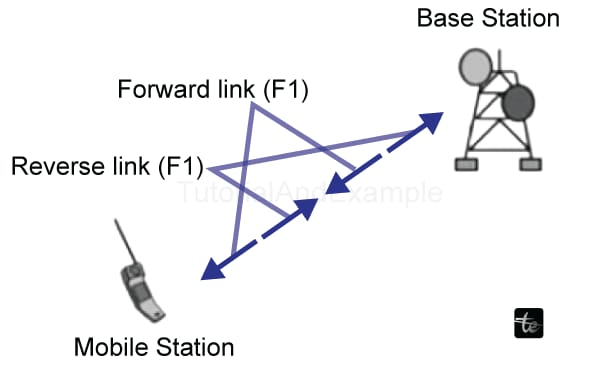
TDD System Ping-Pong Example
TDD employs one band of frequencies for both transmission and reception. It also shares a band by allocating different timeslots for both data transfer and reception operations. Voice, video, nor computer data of bit-serial format can all be transferred. Each time interval might be one byte long or a combination of bytes.
TDD alternates the data from the transmission and receiving stations over time. Timeslots can have varying lengths. The parties communicating cannot imply that the transmissions are intermittent due to the characteristics of high-speed communications. Transmissions that appear to be concurrent are actually competing with one another. No one can argue that it is not a complete duplex when digitally transformed into an analogy voice.
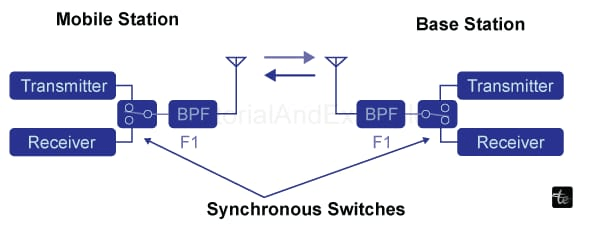
Alternative time intervals of the same duration nor having both DL and UL are used in some TDD systems; however, the system doesn't have to be symmetric 50/50. As needed, the system can be asymmetrical.
For example, when connecting to the Internet, the rate of downloading is usually faster than the upload speed. The majority of the equipment operates in asynchronous mode, which means that the rate of download is faster than the upload rate.
When the downloaded speed exceeds the upload speed, fewer upload timeslots are required. Some TDD formats include dynamic bandwidth allocation, which means that the amount of time divided into intervals or durations can be altered as needed.
The key benefit of TDD is that it just uses one frequency channel and does not require bands guards nor channel separations because the intervals are performed using timeslots. The downside is that good TDD implementation necessitates the use of a timing mechanism. Precision timing is required for both the transmitter & the receiver to ensure that time intervals don't overlap / interfere with one another.
Timing is frequently synchronized to a specific variant of the GPS atomic clock standard. To eliminate duplication, guards' time is also required between timeslots. This time is often equivalent to both transmission-reception processing duration (transmission-reception switching time) as well as the communications channel's transmission delays (latency).
The majority of the equipment operates in asynchronous mode, which means that the rate of download is faster than the upload rate.
3.Duplex Frequency Division:
The forwarded link frequency in Frequency Divided Duplex (FDD) isn't the same as the opposite link frequency. Signals are continuously broadcast in parallel over each link.
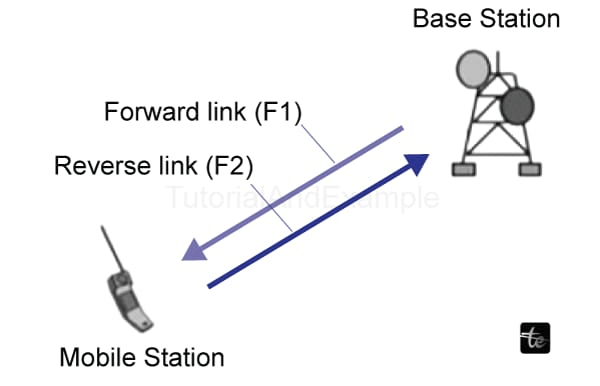
FDD System Illustration:
Frequency Division Duplex System Example FDD needs two symmetrical spectrum segments for the uplink & downlink channels.
When a mobile phone's transmitter and receiver are in such close proximity that the receiver must filter as much of its signal from its transmitter as possible. The more spectrum separation, the more effective the filters.
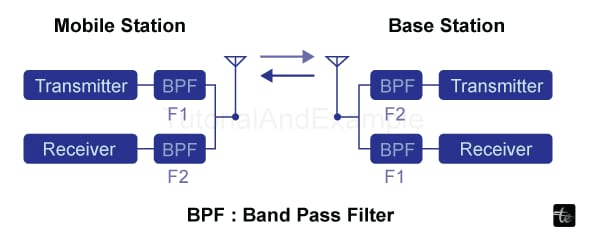
FDD consumes a large amount of frequency spectrum, typically twice that of TDD. Furthermore, there must be appropriate spectrum separation between the channels' transmission and reception. These bands keep claiming that it can't be used and that they are unneeded. They are significant drawbacks given the limited availability and high price of the spectrum.
Using FDD:
FDD is frequently utilized in several cellular phone networks. The band that ranges from 869-894 MHz is utilized for the downlink (DL for short) spectrum from a cell site towers to a device in some systems. Furthermore, the band's 824-849 MHz is utilized as the handset's uplink (UL) spectrum at the cell site.
FDD can also be used on a cable where the transmit and receiver channels are assigned to different sections in the cable spectrum, similar to cable TV systems. Filters are also employed to maintain the channels apart.
FDD's disadvantage:
The disadvantage of FDD is that it can't handle advanced techniques such as numerous antennas, numerous input-output (MIMO), & beamforming. These technologies are critical components of the new LTE (Long Term Evolution) 4G cell phone strategy for increasing data rate. Making a large enough bandwidth to encompass both types of antenna spectrum is difficult. A complicated dynamic adjustment of the circuit is necessary.
Interferences in CDMA
A CDMA transmission is subjected to considerable interference from signals other than CDMA users. Interference comes in two flavors: interference by others using the exact same minicell & interference from nearby cells. Background noise, as well as other erroneous signals, are included in the overall interference.
CDMA employs a spread spectrum method of modulation to encode a signal for transmission and retrieval.
Sources of Noise:
Radio transmissions are disseminated on a single 1.23 MHz broad frequency band with spread spectrum technology. PN codes are assigned to each subscriber. Signals matching the PN code are decoded & processed. Signals that don't include code matching are considered noise and are disregarded.
Signal processing:
Receive CDMA begins with an encoded narrow-band signal, which extends to a bandwidth of 1.23 megahertz with the introduction of PN codes.
The received signal is filtered & processed to recover the intended signal. Because they're unrelated to the desired signals treatment, a correlator reduces sources of interference. The number of CDMA communications that can occupy exactly the same spectrum of frequencies at the same time can be increased using this strategy.
Rate of Frame Error:
The number of transmitted faults expressed in frames error rate (FER). It rises in proportion to the number of calls. To address this issue, the minicell & mobile location can increase power until neither the mobile or minicell site can be powered up sufficiently to lower FER to a suitable level. This event puts a soft restriction on calls from a certain minicell and is dependent on
- The noise floor is caused by both natural and man-made interference.
- Communications on this minicell cause interference.
- Interference from other calls.
Walsh Code of Power:
During call processing, a power control bit is utilized to keep the relative power of every single active traffic channel as well as power up or down to keep acceptable FER readings by the mobile on that channel. This power is measured in digital gain units.
In the transmit path, the actions that follow can be observed:
- In the minicell, a Walsh code spreads the low rate of bit digital speech packet through PSU2 (packet switching unit 2 into the 5ESS switch).
- The spread signal modulates the RF transmission carrier frequency.
- The signal is conveyed via direct sequence spread spectrum.
The receive path has the following actions:
- The signal of direct sequencing spread spectrum is received.
- The RF receiving carrier frequency is used to demodulate the signal.
- The signal is distributed using exactly the same Walsh coding.
- A bit detector converts the decoded signal back to an accurate representation of the original speech pattern.
Methods of Centralization
- The CDMA range spans 824 MHz – 894 megahertz (50 megahertz + 20 MHz gap).
- Code channels are created by dividing the frequency channel.
- The FDMA channel of 1.25 MHz is split across 64 code channels.
CDMA Identities
Network Identities-
- System Identity (SID)
- NID stands for Network Identity.
Identities of Mobile Stations-
- ESN (Electronic Serial Number)
- Permuted ESN
- IMSI (International Mobile Stations Identity)
- IMSI_S
- IMSI_11_12
- Station Class Mark
Capacity for CDMA
The CDMA capacity is determined by the following factors:
- Processing Gain
- Signal-to-Noise Ratio
- Factor of Voice Activity
- Frequency Efficiency in Reuse
Processing Gain:
CDMA was a spread spectrum communication method. A coding sequence separates each data bit. This increases the energy per bit as well. This indicates that we benefit from it.
P (gain) = 10 log (W/R)
W stands for Spread Rate.
R stands for Data Rate.
P (gain) = 10 logarithmic (1228800/9600) = 21dB for CDMA
That is a gain element as well as the actual data transmission rate. A typical transmitting condition necessitates a ratio of signal to noise of 7 dB for good voice quality.
Signal should be five times more powerful than noise in terms of ratio.
P (gain) - SNR = actual processing gain
= 21 – 7 = 14dB
CDMA employs a variable rate coder.
The Voice Activity Factors of 0.4 is taken into account = -4dB.
As a result, CDMA has 100% reuse of frequencies. The usage of the same frequency in adjacent cells produces some additional interference.
The reuse efficiency in CDMA frequency was 0.67 (70% eff.) = -1.73dB.
CDMA provides soft capacity since all users are on the same frequency and separated by code. This indicates that CDMA can function in the presence of interference and noise.
Furthermore, neighboring cells use the same frequencies; thus, there is no re-use. As a result, CDMA capacity estimations should be straightforward. There are no code channels in a cell replicated by no cells. However, it isn't that straightforward. Although there are 64 accessible code channels, it mightn't be possible to utilize all of them at once because the CDMA frequencies are the same.
What is Near-Far CDMA Issue?
The near-far dilemma in CDMA occurs when a mobile station close to the base station's location & another mobile station far from the central station attempt to interact with a central station simultaneously. The signal from the nearby mobile station may be substantially stronger than the connection from the far cell station, resulting in signal loss or considerable deterioration from the distant mobile station. This may result in reduced internet speed and coverage.
Assume three stations named A, B, and C, where terminals of A and B send, as well as terminal C, receives. Because signal strength drops proportionally to distance squared, B's signal drowns out A's signal, and C cannot receive A.
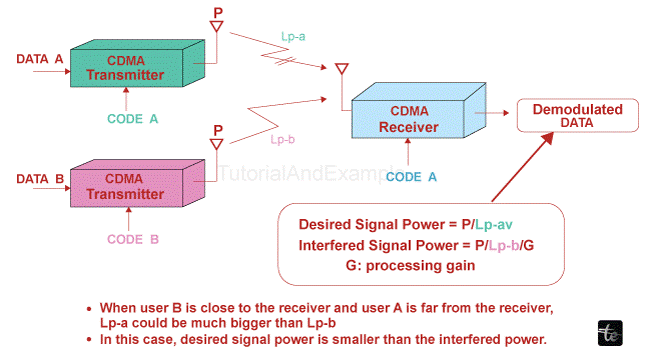
The CDMA near-far problem emerges because phones can be situated anywhere inside the bounds of a specific cell. Some phones will be close to the base station, and others will be far away.
In a free space environment, or according to the inverse square law, increasing distance reduces the signal intensity by a factor of two.
k/(d2) = Signal
Where k is a constant
d = distance
The CDMA Near-Far Problem's Consequences:
- Interference can result in worse call clarity, slower internet speeds, and other difficulties that make people dissatisfied with their service.
- Users with stronger signals living closer to the central station can consume additional network resources, leaving less to users with weaker signals. This could lead to an unequal allocation of resources & a poor user experience for those who live further away.
- When the transmissions of some users are muted or compromised owing to interference, the network's total ability to serve all users is reduced. This may result in dropped calls, sluggish data rates, and other service difficulties as capacity is lowered.
- When a user's signal is obstructed or degraded because of interference, which is the device's power output may need to be increased in order to maintain the connection. As a result of this, the battery may deplete more quickly and last for less time.
Near-Far Problem Solutions
- To address its near-far issue, power control is used. Each base station of a cellular network manages power, ensuring that every mobile device within its service area provides the exact same amount of signal to the base station. This eliminates the problem of nearby followers drowning out the central station's receiver and distant subscribers' signals.
- Interference cancellation is a solution for solving the near-far dilemma that involves screening out unused signals which interfere with a user's communication. A variety of strategies, such as adaptive screening and linear prediction, can be used to accomplish this.
- Sectorization is a possibility. The coverage region of the base station is divided into several sectors, each of which has its own set of frequencies & codes. This enables the network to support more users while reducing consumer irritation.
So that was all related to the CDMA Near Far problem & its potential remedies. Aside from that, there are a variety of other issues that have arisen during mobile and wireless communication, such as the Exposed terminal problem and the Hidden terminal problem. You can read them as well.
CDMA's Benefits
CDMA has a limited capacity. The more codes there are, the more users there are. It has a few benefits:
- Because of the near-far effect, CDMA necessitates strict power control. In simple terms, a user close to the base station transferring at the same power level as the latter will drown the latter's signal. At the receiver, every signal must have roughly equal power.
- Rake receivers can help with signal reception. Delayed versions of the signal's timing (a chip or later) can be gathered and used to make judgments at the bit level.
- It is possible to employ flexible transfer. Mobile base stations may change operators without altering. The mobile signal is received by two base stations, and the phone receives signals through two separate base stations.
- Interference is reduced by using Transmission Burst.
CDMA's disadvantages
The following are the downsides of employing CDMA:
- The length of the code must be carefully chosen. A long code length might create delay or interference.
- Synchronization of time is required.
- The gradual transfer makes better utilization of radio resources while potentially reducing capacity.
- A base station's total power received and sent need constant tight power regulation. This may necessitate many handovers.